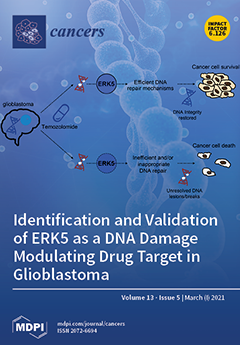Open AccessArticle
CD11c-CD8 Spatial Cross Presentation: A Novel Approach to Link Immune Surveillance and Patient Survival in Soft Tissue Sarcoma
by
Yanhong Su, Panagiotis Tsagkozis, Andri Papakonstantinou, Nicholas P. Tobin, Okan Gultekin, Anna Malmerfelt, Katrine Ingelshed, Shi Yong Neo, Johanna Lundquist, Wiem Chaabane, Maya H. Nisancioglu, Lina W. Leiss, Arne Östman, Jonas Bergh, Saikiran Sedimbi, Kaisa Lehti, Andreas Lundqvist, Christina L. Stragliotto, Felix Haglund and Monika Ehnman
Cited by 1 | Viewed by 3898
Abstract
Checkpoint inhibitors are slowly being introduced in the care of specific sarcoma subtypes such as undifferentiated pleomorphic sarcoma, alveolar soft part sarcoma, and angiosarcoma even though formal indication is lacking. Proper biomarkers to unravel potential immune reactivity in the tumor microenvironment are therefore
[...] Read more.
Checkpoint inhibitors are slowly being introduced in the care of specific sarcoma subtypes such as undifferentiated pleomorphic sarcoma, alveolar soft part sarcoma, and angiosarcoma even though formal indication is lacking. Proper biomarkers to unravel potential immune reactivity in the tumor microenvironment are therefore expected to be highly warranted. In this study, intratumoral spatial cross presentation was investigated as a novel concept where immune cell composition in the tumor microenvironment was suggested to act as a proxy for immune surveillance. Double immunohistochemistry revealed a prognostic role of direct spatial interactions between CD11c+ antigen-presenting cells (APCs) and CD8+ cells in contrast to each marker alone in a soft tissue sarcoma (STS) cohort of 177 patients from the Karolinska University Hospital (MFS
p = 0.048, OS
p = 0.025). The survival benefit was verified in multivariable analysis (MFS
p = 0.012, OS
p = 0.004). Transcriptomics performed in the TCGA sarcoma cohort confirmed the prognostic value of combining CD11c with CD8 (259 patients,
p = 0.005), irrespective of
FOXP3 levels and in a
CD274 (PD-LI)-rich tumor microenvironment. Altogether, this study presents a histopathological approach to link immune surveillance and patient survival in STS. Notably, spatial cross presentation as a prognostic marker is distinct from therapy response-predictive biomarkers such as immune checkpoint molecules of the PD-L1/PD1 pathway.
Full article
►▼
Show Figures






